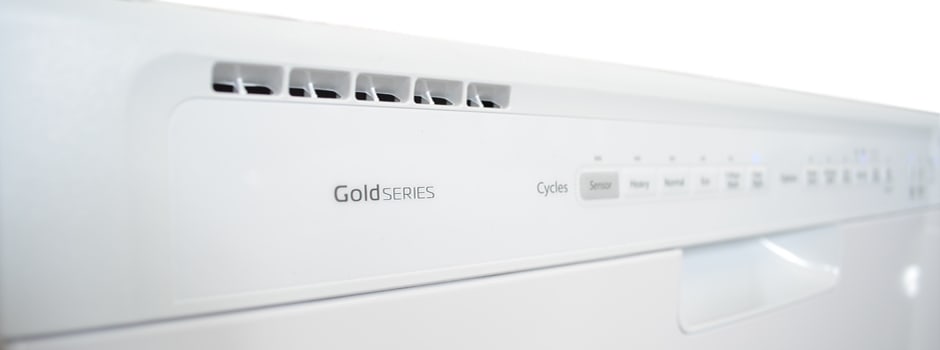Introduction
Available for around $500, we don’t imagine owners will have too many complaints. AS with most machines in the Gold Series, the WDF730PAYW is not meant to astonish users, but it certainly manages to avoid disappointment.
Design & Usability
{{section_header}}{{ section.name }}{{/section_header}}
Whoa! A white Whirlpool dishwasher? Get out!
We’re not huge fans of Whirlpool’s incessant use of this bright white tone, and the front control panel does little to impress fans of high-end appliance design. But, clearly, this machine is built for function, not form.
Even so, the control panel definitely has a cheap feel to it. The entire interface is push-button operated, but the responsiveness of these buttons is, well, somewhat lacking. That being said, the range of controls is thorough, allowing for intuitive operation and customization. This is impressive given the price range.
As far as the interior goes, we were less impressed with the lower rack, which has a single adjustability mechanism that is frustrating, to say the least. Essentially, there is an additional row of tines that you can slide from side to side, but all this did was get in the way. While we were still able to fit the standard 10 place settings, it required some serious, clumsy maneuvering to reach. We’ve seen this sliding mechanism in other Whirlpool models, and we hope it goes away soon.
{{photo_gallery "Design Gallery"}}
Features
{{section_header}}{{ section.name }}{{/section_header}}
A couple of unique options mixed with an array of familiar features
There are two unique features to the WDF730PAYW—well, at least their unique to Whirlpool. There’s the Power Scour option, which, according to Whirlpool, uses 40 spray jets to “scour away baked on foods.” It also includes a series of larger jets that help clean large dishware without soaking or scrubbing. There is also an additional “Sensor” cycle that adjust cycle length and intensity according to the volume of food soils remaining in the wash tub.
Aside from these proprietary features, the WDF730PAYW also features the standard array of wash options: an “Eco” cycle, which is more energy- and water- efficient; an Over Night cycle, which lasts longer in order to preserve water and energy; Hi-Temp Wash option; Sani Rinse; Heat Dry; and Delay (2, 4, or 8 hours).
Performance
{{section_header}}{{ section.name }}{{/section_header}}
We were pleasantly surprised by the WDF730PAYW’s performance.
Given the low cost and cheap build, we were pleasantly surprised by the quality of the WDF730PAYW’s wash cycles. While we were not exactly awestricken, our data show a clear knack for scrubbing dishes. The 1-Hour Wash, not surprisingly, was not very effective, but both the Normal and Heavy washes did very well on some of our most difficult stain tests, including burnt milk, baked-on egg, burnt cheese, and baked-on spinach.
However, we’d recommend staying away from the 1-Hour Wash altogether—unless you’re hard-pressed to get some dishes cleaned within the hour, of course. But that’s probably a rare occasion. The Heavy cycle scored the highest, which is impressive because that cycle includes three additional stains. Usually, because of these three additional stains, the Normal cycle ends up scoring the highest. Interestingly, there was not much of a difference between these two cycles in terms of efficiency and duration. Check out our science page for the raw data.
Conclusion
{{section_header}}{{ section.name }}{{/section_header}}
The $500 price tag is fair for what you get.
Were the WDF730PAYW just $100 more we’d be reluctant to give it our recommendation, but $500 is a very fair price, and you’ll get your money’s worth. Here are our biggest qualms: the design, the clumsy lower rack layout, and the duration of the cycles. In the end, though, these are not huge issues. Obviously, you’ll have to factor the WDF730PAYW’s lazy design into your kitchen layout, but if that’s not a concern we don’t imagine many folks will have many problems with this dishwasher. After all, it is sufficient at cleaning dishes, and that’s the most important thing.
Introduction
{{section_header}}{{ section.name }}{{/section_header}}
Talk is cheap; science is not. That’s why our reviews are all based on raw, field-tested data. Read on to see how the Whirlpool WDF730PAYW fared in our performance, efficiency, and capacity tests.
Performance
{{section_header}}{{ section.name }}{{/section_header}}
While the 1-Hour Wash was "meh," the Normal and Heavy cycles were clear powerhouses.
As mentioned in the body our this review, the Heavy cycle was the highest performer. This is somewhat rare because it’s the only cycle we test with additional stains—and it handled these test with great aplomb! Sorry, I love that word and wanted to shoehorn it into a review.
The most notable example of the heavy cycle’s prowess was its handling of the burnt cheese test. On the first pass it completely removed every trace of the cheese, which almost never happens. On the second, it still removed more than 95 percent. It also scored perfectly in our baked-on oatmeal, baked-on egg, burnt sugar, tea and margarine stains. Even the spinach test, which is specifically designed to fail, neared perfection.
The Normal cycle was also impressive, but a bit more inconsistent. In one pass it scored perfectly in our milk, tea, egg, oatmeal, and margarine tests, but on the other pass it only scored perfectly on our oatmeal test. We recommend cleaning the filter frequently to avoid soils being sprayed throughout the interior of the machine—a common occurrence, but one that was less an issue with the WDF730PAYW.
{{photo_gallery "Performance Gallery"}}
Efficiency
{{section_header}}{{ section.name }}{{/section_header}}
Somewhat on the efficient end, the WDF730PAYW is not likely to rack your utility bill.
The WDF730PAYW seemed to fall right in the 50th percentile in our efficiency testing. There was nothing exorbitantly wasteful about this machine, but it’s also not going to win any environmental awards.
Our tests showed the Normal wash consumed 1.09 kWh per cycle, for an energy cost of 11 cents. The 1-Hour Wash and Heavy used 0.35 and 1.12 kWh, respectively. This makes an electricity cost of 4 to 12 cents.
In regards to water, we found the Normal cycle used a measly 2.85 gallons of hot water—for a water cost of roughly 3 cents per wash—but the Heavy wash drained 7.67 gallons, making for a water cost of 7 cents. Interestingly, the 1-Hour Wash used as much as 5.09 gallons.
In all, this makes for a total cost per wash of 11 cents on the 1-Hour Wash, 15 cents on the Normal, and 22 cents on the Heavy. All this data calculates to an estimated yearly operating cost of $32.98—a perfectly reasonable figure.
{{photo_gallery "Efficiency Gallery"}}
Capacity
{{section_header}}{{ section.name }}{{/section_header}}
A not surprising and completely expected capacity score
Not surpassingly, the WDF730PAYW was utterly standard in regards to its dish capacity. We were able to fit 10 place settings, including a serving setting, which is perfectly adequate for almost all domestic dishwashing needs.
For your information, a place setting includes dinner plate, bread plate, fruit bowl, glass, saucer, mug, dinner fork, knife, and two spoons; and a serving settings includes platter, serving bowl, fruit bowl, and three serving utensils.
{{photo_gallery "Capacity Gallery"}}
Meet the tester
Tyler Wells Lynch is a freelance writer and journalist whose work has appeared in Vice, Wirecutter, Gizmodo, The Rumpus, Yes!, and the Huffington Post, among others. He lives in Maine.
Checking our work.
Our team is here for one purpose: to help you buy the best stuff and love what you own. Our writers, editors, and lab technicians obsess over the products we cover to make sure you're confident and satisfied. Have a different opinion about something we recommend? Email us and we'll compare notes.
Shoot us an email


